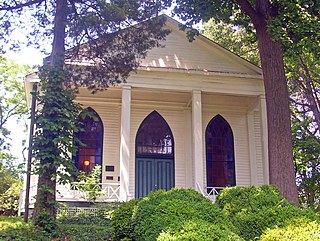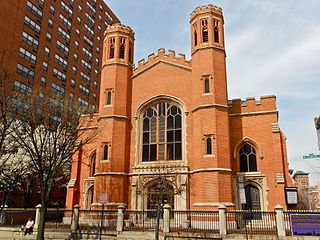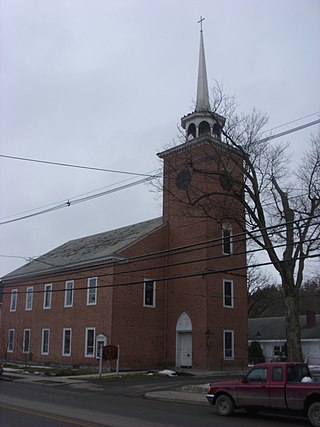The African Union First Colored Methodist Protestant Church and Connection, usually called "the A.U.M.P. Church", is a Methodist denomination. It was chartered by Peter Spencer (1782–1843) in Wilmington, Delaware, in 1813 as the "Union Church of Africans", where it became known as the "African Union Church".

The Mother Bethel African Methodist Episcopal Church is an historic church and congregation which is located at 419 South 6th Street in Center City Philadelphia, Pennsylvania, USA. The congregation, founded in 1794, is the oldest African Methodist Episcopal congregation in the nation.

St. Peter's Evangelical Lutheran Church, or Iglesia Luterana San Pedro, is a historic church complex located in the Walker's Point neighborhood of Milwaukee, Wisconsin. Its buildings are listed on the National Register of Historic Places.

The Stevensville Historic District, also known as Historic Stevensville, is a national historic district in downtown Stevensville, Queen Anne's County, Maryland. It contains roughly 100 historic structures, and is listed on the National Register of Historic Places. It is located primarily along East Main Street, a portion of Love Point Road, and a former section of Cockey Lane.

Charles Street African Methodist Episcopal Church is an historic African Methodist Episcopal Church at 551 Warren Street in Boston, Massachusetts. The current church building was built in 1888 by J. Williams Beal and added to the National Register of Historic Places in 1983.

The Bethesda Meeting House is a historic Presbyterian church complex in Bethesda, Montgomery County, Maryland, US. Its name became the namesake of the entire surrounding community in the 1870s. It sits on Maryland Route 355 just inside the Capital Beltway. It has been listed on the National Register of Historic Places since 1977.

Franklin Street Presbyterian Church and Parsonage is a historic Presbyterian church located at 100 West Franklin Street at Cathedral Street, northwest corner in Baltimore, Maryland, United States. The church is a rectangular Tudor Gothic building dedicated in 1847, with an addition in 1865. The front features two 60 foot flanking octagonal towers are also crenelated and have louvered belfry openings and stained glass Gothic-arched windows. The manse / parsonage at the north end has similar matching walls of brick, heavy Tudor-Gothic window hoods, and battlements atop the roof and was built in 1857.

Mount Vernon Place United Methodist Church and Asbury House is a historic United Methodist church located at 2-10 Mount Vernon Place, Mount Vernon in Baltimore, Maryland. The church "is one of the most photographed buildings in the city, completed in 1872 near the Washington Monument on the site where Francis Scott Key died in 1843. Its sanctuary seats 900 and its rose window is modeled after the one in the Notre Dame Cathedral in Paris."

Riverside Methodist Church and Parsonage is a historic Methodist church and parsonage on Charles and Orchard Streets in Rhinecliff, Dutchess County in the U.S. state of New York. The church was built about 1859 and the parsonage about 1888. The church is a small, two-story, rectangular stone building in the Gothic Revival style. It features a steeply pitched gable roof covered in polychrome slate. It has an open-frame bell tower and is built into the side of a hill. The parsonage is a two-story, T-shaped frame dwelling topped by a cross-gable roof. Also on the property is a contributing garage.

The Mechanicsburg Baptist Church is a historic church in the village of Mechanicsburg, Ohio, United States. Constructed for a Methodist congregation in the late nineteenth century, the building was taken over by Baptists after the original occupants vacated it, and it has been named a historic site.

St. John's United Methodist Church is located in central Davenport, Iowa, United States. It was listed on the National Register of Historic Places in 1983.

First United Methodist Church is a historic congregation of the United Methodist Church in downtown London, Ohio, United States. Founded in London's earliest years, the congregation worships in a historic church building that was built in the 1890s.

St. Paul's United Methodist Church is located in downtown Cedar Rapids, Iowa, United States. The Louis Sullivan-designed building has been individually listed on the National Register of Historic Places since 1985. In 2000 it was included as a contributing property in the Second and Third Avenue Historic District.

The Bethel A.M.E. Church, known in its early years as Indianapolis Station or the Vermont Street Church, is a historic African Methodist Episcopal Church in Indianapolis, Indiana. Organized in 1836, it is the city's oldest African-American congregation. The three-story church on West Vermont Street dates to 1869 and was added to the National Register in 1991. The surrounding neighborhood, once the heart of downtown Indianapolis's African American community, significantly changed with post-World War II urban development that included new hotels, apartments, office space, museums, and the Indiana University–Purdue University at Indianapolis campus. In 2016 the congregation sold their deteriorating church, which will be used in a future commercial development. The congregation built a new worship center at 6417 Zionsville Road in Pike Township, Marion County, Indiana.

Zion Lutheran Church, also known as the Zion Church of the City of Baltimore, is a historic Evangelical Lutheran church located in downtown Baltimore, Maryland, United States, founded 1755.
Petersville is an unincorporated community in Frederick County, Maryland, United States. Petersville is located at the junction of Maryland routes 79 and 180, 1.3 miles (2.1 km) northeast of Rosemont.

The Bare Hills Historic District encompasses a residential area north of Baltimore, Maryland, in Baltimore County, which had industrial beginnings before being transformed into a suburb of the city. The district includes Lake Roland Park as well as a cluster of largely vernacular dwellings between the park and Falls Turnpike that was built mainly in the 19th century.

St. Paul's Lutheran Church Historic District, also known as Schoharie United Presbyterian Church, is a historic Lutheran church complex and national historic district located at Schoharie, Schoharie County, New York. The complex consists of the former St. Paul's Lutheran Church, an 1801 manse, St. Paul's Lutheran Cemetery, and the old Lutheran Parsonage. The church was built in 1796, and is a two-story rectangular brick building. The front facade features a square, multistage entrance tower capped by an octagonal belfry and spire. The new manse was built in 1801, and is a five bay, two-story, double pile, heavy timber frame Federal style dwelling with a two-story rear ell. The church cemetery has several thousand graves, with the earliest marked grave dated to 1778. The Old Lutheran Parsonage was built in 1743, and is separately listed. In 1920, the local Lutheran and Methodist congregations joined, and in 1960, the congregation voted to affiliate with the Presbyterian denomination.

The St. John's Congregational Church and Parsonage-Parish for Working Girls are a pair of historic religious buildings at 69 Hancock and 643 Union Streets in Springfield, Massachusetts. The church, built in 1911 for an African-American congregation founded in 1889, is a well-preserved example of English and Gothic Revival architecture. The parsonage, built in 1913, is a little-altered example of Colonial Revival architecture. Both buildings are important in the history of Springfield's African-American community, and were listed on the National Register of Historic Places in 2016. The church building is now occupied by a different congregation, the original having moved to larger quarters across Union Street; the parsonage house continues to be used by the St. John's congregation as an education center.

Quinn Chapel African Methodist Episcopal (AME) Church was the first Black church to be founded in Lincoln, Nebraska.




























